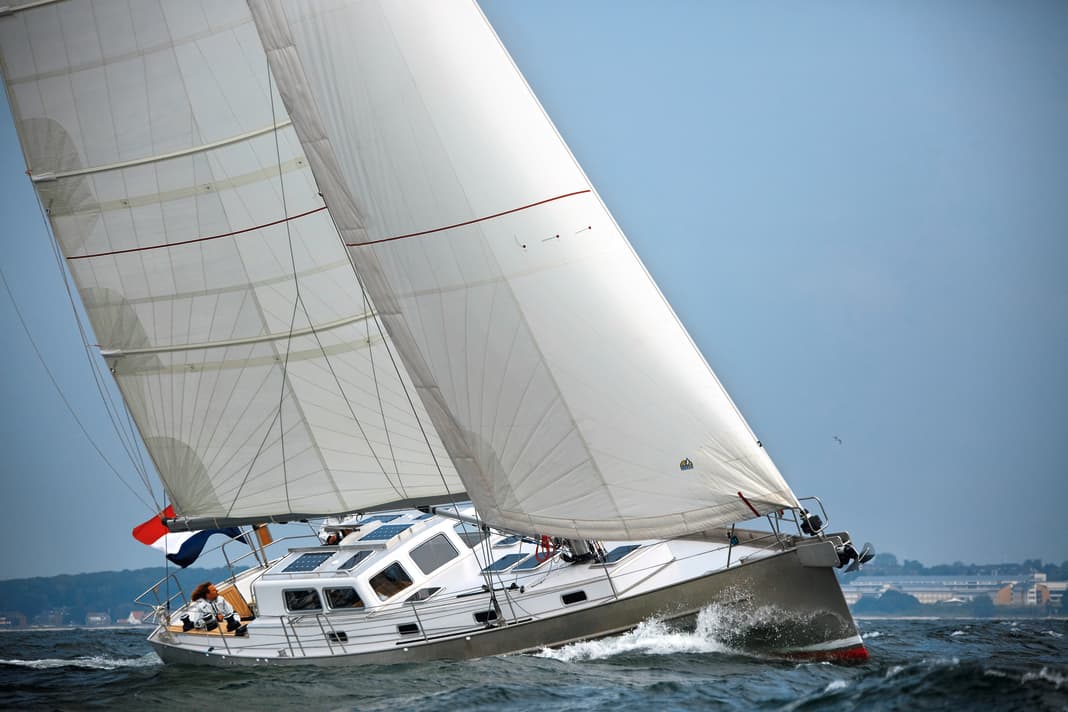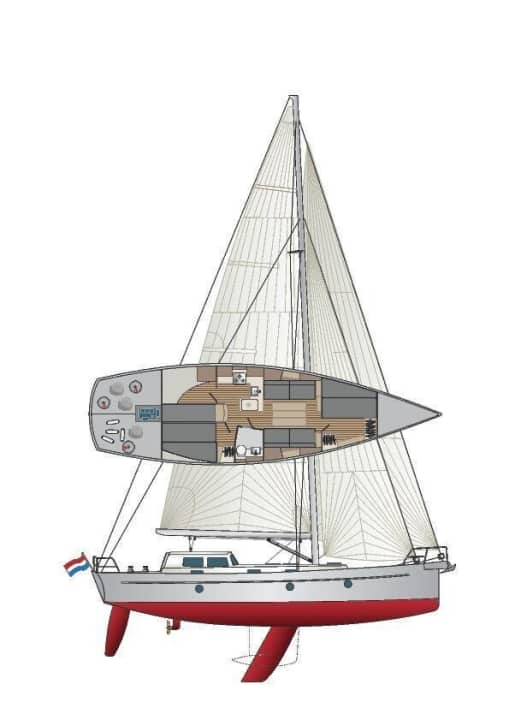Bestevaer 45 ST Pure: Robust long-distance yacht with adventure flair from KM Yachtbuilders






It leaves nobody cold. When you see the Bestevaer with the somewhat unwieldy name suffix 45 ST Pure, you don't pass by without thinking, as can happen with one or two large series yachts. The stone-grey aluminium colossus immediately conjures up associations. Confidence and robustness come to mind, along with reliability, long journeys, adventure and vastness. He sees a bulwark, a solid rubbing strake on the high freeboard, generously dimensioned fittings, solid handles. And above all, he sees a distinctive deckhouse, which alone gives the boat an all-weather aura.
The Bestevaer 45 thus follows in the tradition of the upmarket aluminium company KM Yachtbuilders from Makkum in the north of the Netherlands, which produces various fine products for long journeys and good taste. The Dutch company builds according to plans by van de Stadt, Koopmans, Frers, Berckemeyer and Hoek, and often favours the designs of Dykstra Naval Architects. The renowned large team is known above all for various newly built J-Class yachts and for upscale long-distance yachts. At the time of our visit, boss Gerard "Gerry" Dykstra was personally sailing a Bestevaer 53, and whenever possible in the high latitudes. Not a bad sign of confidence in the shipyard.
KM Yachtbuilders is celebrating its 25th anniversary this year and invites you to an open day on 22 April 2023. The event is an excellent opportunity to step aboard a KM sailing yacht, tour the shipyard, talk to the experts and meet the people who created these yachts.
The sailing yacht exudes confidence for long voyages
Shipyard boss Eeuwe Kooi, who founded KM in 1999 by taking over a renowned aluminium yacht manufacturer, is expanding his programme with the Bestevaer 45. While Makkum produces one-offs and semi-one-offs as well as individual parts for Royal Huisman, among others, the new line stands for series-produced vessels.
However, the shipyard DNA is to be retained; it is synonymous with safety, seaworthiness and comfort. The customer has significantly fewer options than with the larger sisters. Nevertheless, there is a choice between a swivelling or fixed keel, one or two aft cabins and an island bed or a bunk in the foredeck that is offset to one side.
Details that are not yet of interest when first boarding and travelling. The visitor wants to set off with this boat. The bow thruster makes up for the disadvantages of the twin rudder system when manoeuvring from a standing start. Doyle's six-battened main climbs 20 metres into the sky on Seldén's twin spreader mast, electrically assisted by one of six (!) 50-rake winches. The slightly overlapping genoa is unfurled, the boat lays a little on the jib and accelerates ponderously but unstoppably like a goods train to a high speed of 7 to 8 knots on the mooring.
The Bestevaer 45 steers calmly through any weather
Striking: the crew of four likes to move around a lot on and below deck, even in 5 Beaufort and corresponding swell. The sailing yacht works its way calmly and rhythmically through the waves, there are various places to hold on, and the space is large, but always parcelled out in such a way that you can support yourself, lean on and hold on. This applies to the saloon, the seaworthy galley and the wet room as well as the cabins. In wind and weather, you can sit comfortably in the deckhouse and let the autopilot steer.
The long passage on this sailing yacht must be amazing. The only drawback: the two sofas in the deckhouse are only 1.40 metres long, so they are not suitable for sleeping for the free or even better for the standby crew, who would lie there within calling distance of the watch. But there would be room for a longer deckhouse; the cockpit measures a full three metres! Two crew members find some protection in a fixed extension of the deckhouse. However, it takes time before you stop bumping your head on the sliding hatch guide, which has also been extended.
The solid aluminium hull has watertight bulkheads
However, the most special feature in the cockpit of the sailing yacht is the long, curved tiller, which is used to move the two blades via rods. Once the boat is well trimmed and underway, this is relatively simple and effortless. However, the complex mechanism is noticeable when turning. Sitting in the cockpit, the helmsman has to look through the superstructure. However, the boat is easy to steer even with a tiller jib; you then sit on the coaming between the winches and have direct access to the sheets. However, the Bestevaer is optionally available with a wheel.
A good solution: all halyards and sheets lead aft to the six coaming winches, making the boat perfectly suitable for single-handed sailing. If the boat sails very well on the beam and with slightly sheeted sheets, it lacks a little speed or height on the cross, at least with the tested swing keel version. A fixed keel with a bomb is fitted as standard. In both cases, the ballast ratio is quite high, at least 37 per cent.
That fits. The interior is more surprising: lots of light-coloured surfaces, green upholstery and bamboo veneer, plus circular bulleys and a dark floor - a matter of taste, as is the design of the port aft cabin. It is open to the galley and has no footwell, making it look more like a dog bunk. Alternatively, a further forecastle box is possible here, whereby the cockpit already has a gigantic amount of storage space.
The berths are narrow, the galley spacious
What is also striking is that the berths are all quite narrow. Even the one in the foredeck, which is offset to the side, is only 1.30 metres wide at shoulder height. The alternative island bed on offer will be the better solution. The headroom, another important comfort dimension, is naturally generous on a boat in this league; it is at least 1.90 metres.
The U-shaped galley deserves a mention: it impresses with two fridges, plenty of worktop space, various intelligently utilised storage spaces, a three-burner oven hob and a horizontal and a vertical bar to hold on to. The latter is the "standpijp", the standpipe often used in Dutch boatbuilding. The grey water connections end in it.
Is something missing? That's right: there is no dedicated navigation corner on the boat; chart work, if desired, takes place electronically or at the saloon table. An area in the deckhouse above the starboard aft cabin could be used, but this would be uncomfortable. Also a matter of taste.
The sailing yacht impresses in terms of handling and comfort
But there is no doubt about it: The sailing yacht is a stunner - far ahead in the disciplines of handling, sailing comfort and space, with exemplary solutions, sophisticated on-board technology and plenty of storage space. It is also ideally suited for extended tours, possibly all year round or in high latitudes - which standard shipyard includes a classic Dickinson diesel stove in the price list? However, the glazing in the deckhouse would still need some work. The hull itself is prepared with PU foam on the inside.
KM Yachtbuilders is now competing against brands such as Garcia, Allures and Ovni from France and Benjamins from Germany with this series-produced boat. It's just a shame that something like the Bestevaer 45 ST Pure isn't available in a slightly smaller version. And perhaps with a shorter name.
This article first appeared in YACHT 16/2016
Technical data Bestevaer 45 ST Pure

- Design: Dykstra Naval Architects
- CE design category: A
- Torso length:14,45 m
- Width:4,05 m
- Draught/alternative.: 2,15/1,40-2,95 m
- Weight: 13,0 t
- Ballast/proportion (swivelling keel): 4,9 t/37 %
- Mainsail: 60,0 m²
- Furling genoa: 45,0 m²
- machine (Yanmar):57 kW/42 hp
Hull and deck construction
Seawater-resistant aluminium in round frame.
Over fibre optic cable 5-6 mm, under fibre optic cable 6-12 mm
Price and shipyard
- Base price ex shipyard: € 589,050
- Price ready to sail*: € 589,050
- Comfort price*: € 618,137
- Warranty: 1 year
- Shipyard: KM Yachtbuilders, De Stienplaat 7, 8754 HE Makkum/Netherlands; Tel. 0031/515 233 000; www.kmy.nl
(Prices as of Q3/2016)
* how the prices shown are defined can be found here !

